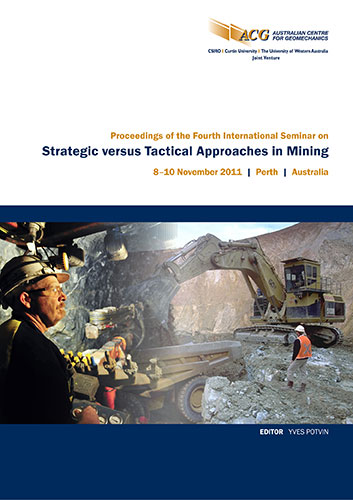Production rate optimisation – avoiding the temptation of tonnage

|
Authors: McCarthy,P |
DOI https://doi.org/10.36487/ACG_rep/1108_01_McCarthy
Cite As:
McCarthy,P 2011, 'Production rate optimisation – avoiding the temptation of tonnage', in Y Potvin (ed.), Strategic versus Tactical 2011: Proceedings of the Fourth International Seminar on Strategic versus Tactical Approaches in Mining, Australian Centre for Geomechanics, Perth, pp. 3-10, https://doi.org/10.36487/ACG_rep/1108_01_McCarthy
Abstract:
A feasibility study is a prediction of future events. Modern computing techniques have allowed estimates to be made with increasing precision but may not have improved their accuracy. A mine (including mill and infrastructure) is a complex dynamic system, so that any description of a future mine built up from estimates of its component parts must be tempered by an appreciation of how the system performs as a whole. While software models are proceeding toward the goal of whole-system simulation, the models must be calibrated against real-world performance. This can only be achieved by benchmarking modelled performances and costs against comparable real-world examples. With the current level of sophistication of modelling, benchmark data must take precedence over model outputs and in that respect we may be no more advanced in predicting whole-of-mine performance than we were in the pre-computer era. One key optimisation parameter is the mine’s production rate. If a scheduling package suggests that a particular production rate can be achieved then this must be verified and moderated by benchmarking, with particular regard to the relationship between production rate and head grade. The assumption that “economies of scale” will result from increasing throughput rates needs to be balanced by an awareness of the adverse effects of increasing the rate beyond a level that is supportable by the resource. At low to moderate production rates the forecast ore reserve grade and mining recovery may be achieved comfortably. However, as the challenge of meeting production targets increases, mining becomes less selective, more waste finds its way into the ore steam and ore that requires careful extraction may be abandoned. Without changing the intended cutoff grade, the actual head grade will fall as the mining rate increases. This effect is known to people at operations but is not generally recognised in current ore reserve estimation methodology or in mine optimisation studies. The dependency of head grade on mining rate can be quantified and used to establish the economically optimum mining and processing rate for a new project. A practical analysis is set out based on real-world examples.
References:
Hoover, H.C. (1909) Principles of Mining, McGraw-Hill, New York, pp. 153–160.
McCarthy, P.L. (1993) Economics of Narrow Vein Mining, in Seminar Narrow Vein Mining, Australasian Institute of Mining and Metallurgy, 17–18 June, Bendigo, Australia, pp. 89–97.
McCarthy, P.L. (2010) Setting Plant Capacity, Metallurgical Plant Design and Operating Strategies, Transactions of the Institution of Mining and Metallurgy – Section C, Vol. 119, No. 4, pp. 184–190.
Mudd, G.M. (2009) The Sustainability of Mining in Australia: Key Production Trends and Their Environmental Implications for the Future, Research Report No RR5, Department of Civil Engineering, Monash University and Mineral Policy Institute, Revised April 2009.
Smith, L.D. (1997) A Critical Examination of the Methods and Factors Affecting the Selection of an Optimum Production Rate, CIM Magazine, Bulletin Vol. 90, No. 1007, February 1997.
Tatman, C.R. (2001) Production Rate Selection for Steeply Dipping Tabular Deposits, Mining Engineering, October 2001, pp. 62–64.
© Copyright 2025, Australian Centre for Geomechanics (ACG), The University of Western Australia. All rights reserved.
View copyright/legal information
Please direct any queries or error reports to repository-acg@uwa.edu.au
View copyright/legal information
Please direct any queries or error reports to repository-acg@uwa.edu.au